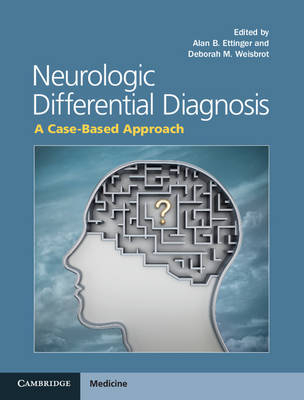
Neurologic Differential Diagnosis
Cambridge University Press (Verlag)
978-1-107-01455-8 (ISBN)
The increasing pressure upon clinicians to see more and more patients generates great concern as to how to offer a comprehensive and thorough diagnostic approach and yet maintain efficiency. Neurologic Differential Diagnosis is the answer. Unlike other texts which are divided into disease entities, this book uses a case study approach to focus on the patients' symptoms. Each chapter is dedicated to a specific presenting symptom or sign and includes a comprehensive, yet succinct table of clinical features to aid clarification of the broad list of diagnostic possibilities. This allows the clinician to quickly reference specific symptoms such as dizziness, mental status change or diplopia; or signs such as foot drop or psychotic behavior, and then immediately generate diagnostic possibilities. Written from the authors' extensive clinical experience, Neurologic Differential Diagnosis is an invaluable text for neurologists and psychiatrists at all stages of training.
Alan B. Ettinger is Epilepsy Director, Neurological Surgery PC, Rockville Center; Director of the Epilepsy Wellness Program, Winthrop University Hospital, Mineola; Director of EEG and Epilepsy, Huntington Hospital, Huntington; and Professor of Clinical Neurology, Albert Einstein College of Medicine, Bronx, NY, USA. Deborah M. Weisbrot is Associate Professor of Clinical Psychiatry and Director, Child and Adolescent Psychiatry, Outpatient Clinic, Department of Psychiatry and Behavioral Sciences, Stony Brook University Medical Center, New York, USA.
Foreword; Preface; Part I. Differential Diagnosis of Abnormal Symptoms and Signs: 1. Introduction: localization and differential diagnosis in neurology; 2. Agitation and aggressive behavior in patients with dementia or developmental disability; 3. Agnosias; 4. Anxiety and panic; 5. Aphasia; 6. Apraxia; 7. Ataxia: subacute or chronic; 8. Ataxia, acute, or subacute; 9. Attentional problems; 10. Autonomic failure or syndromes; 11. Bulbar, pseudobulbar; 12. Catatonic-like states; 13. Chorea; 14. Coma; 15. Dementia; 16. Depression and suicidal ideation; 17. Diplopia; 18. Dissociative disorder; 19. Dizziness; 20. Drop attacks; 21. Dysarthria; 22. Dysphagia; 23. Dystonia; 24. Eating disorders; 25. Eye movements, abnormal; 26. Falls; 27. Foot drop; 28. Gait abnormalities; 29. Hallucinations, visual; 30. Headache; 31. Hearing deficit; 32. Hypersomnolence; 33. Incontinence; 34. Mania and bipolar symptoms; 35. Medically unexplained symptoms; 36. Memory loss and cognitive decline, acute and subacute, amnesia; 37. Mental status change, acute [and delirium]; 38. Movement disorders in psychiatric disorders; 39. Movement abnormalities in the face; 40. Movements, focal, clonic; 41. Movements, complex motor activity; 42. Movements during sleep; 43. Movements, tonic-clonic type; 44. Mutism; 45. Myalgia, cramps; 46. Myoclonus; 47. Myotonia; 48. Nystagmus; 49. Ophthalmoparesis, gaze conjugate lateral deficit and conjugate vertical deficit; 50. Pain, eye; 51. Pain, neck; 52. Pain, arm; 53. Pain, back; 54. Pain, face; 55. Papilledema; 56. Paresthesias; 57. Parkinson's Disease and related extrapyramidal syndromes; 58. Proptosis [exophthalmos]; 59. Psychosis, thought disorder; 60. Ptosis; 61. Pupil constriction and Horner's syndrome; 62. Pupil dilatation; 63. Respiratory difficulties, neurologic causes; 64. Retardation, mental; 65. Seizure; 66. Sensory deficits and abnormal sensations; 67. Sensory deficits in the face; 68. Smell deficit; 69. Spasm, hemifacial; 70. Stroke and hemorrhage syndromes; 71. Stroke in adults, etiologies; 72. Stroke in the young, etiologies; 73. Syncope; 74. Tinnitus; 75. Tremor; 76. Vertigo; 77. Visual loss, acute bilateral; 78. Visual loss, monocular; 79. Visual field deficits; 80. Weakness, generalized acute; 81. Weakness, hemiparesis; 82. Weakness, proximal; 83. Weakness, monomelic; 84. Weakness, neck; 85. Weakness, paraparesis; 86. Weakness in ICU; Part II. Differential Diagnosis within Specific Localizations: 87. Cavernous sinus syndrome; 88. Facial nerve palsy; 89. Fourth nerve palsy; 90. Myelopathy; 91. Nerve, cranial: multiple deficit; 92. Neuropathy, tibial; 93. Neuropathy, femoral; 94. Neuropathy, radial; 95. Neuropathy, sciatic; 96. Neuropathy, axonal versus demyelinating; 97. Neuropathy, median and carpal tunnel; 98. Neuropathy, ulnar; 99. Plexopathy, brachial; 100. Plexopathy, lumbar; 101. Radiculopathy; 102. Sixth nerve palsy; 103. Third nerve palsy; Index.
| Zusatzinfo | 175 Tables, black and white; 53 Halftones, unspecified; 58 Line drawings, unspecified |
|---|---|
| Verlagsort | Cambridge |
| Sprache | englisch |
| Maße | 193 x 252 mm |
| Gewicht | 1620 g |
| Themenwelt | Geisteswissenschaften ► Psychologie ► Klinische Psychologie |
| Medizin / Pharmazie ► Medizinische Fachgebiete ► Neurologie | |
| Medizin / Pharmazie ► Medizinische Fachgebiete ► Psychiatrie / Psychotherapie | |
| Studium ► 2. Studienabschnitt (Klinik) ► Anamnese / Körperliche Untersuchung | |
| ISBN-10 | 1-107-01455-7 / 1107014557 |
| ISBN-13 | 978-1-107-01455-8 / 9781107014558 |
| Zustand | Neuware |
| Haben Sie eine Frage zum Produkt? |
aus dem Bereich


